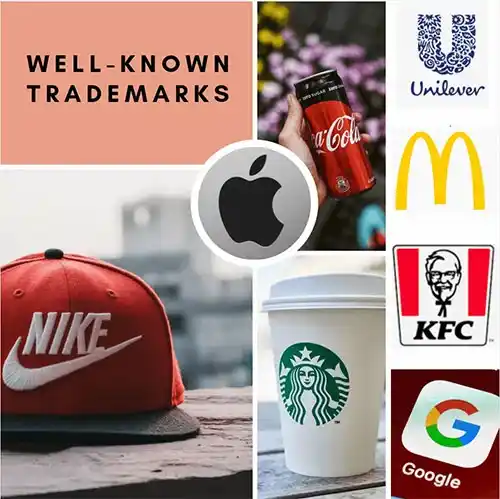Well-Known Trademarks : Examples and Process
A well-known trademark is a mark that is widely recognized by the general public and is associated with a popular company or brand. These trademarks are often known as “famous” trademarks and enjoy a higher degree of protection under the Trademark Act, when compared to regular registered marks.
For instance, while a regular registered trademark is protected only within the specific class of goods or service to which it belongs and only within the specific geographical location where it is registered, well-known trademarks enjoy protection across all classes of goods or services and across all geographical locations. This means that if the trademark of your company is similar to a well known mark, you will not be able to use it, even if it belongs to a different class of goods or service compared to that of the well known mark.
Examples of Well-Known Trademarks

- Tata
- Coca-Cola
- Apple
- Nike
- McDonald’s
- Amazon
These trademarks are not only recognized globally but are also associated with the products and services that these companies offer. They are protected by both national and international trademark laws and are highly valuable assets for their owners.
The Process of Obtaining a Well-Known Trademark
To obtain the status of a well-known mark, a company must prove that their trademark is widely recognized by the general public. This process can be quite challenging, as it requires a significant amount of evidence to demonstrate the mark’s reputation. The following factors are considered when determining whether a mark is well-known or not :
- The duration, extent, and geographical area of any use of the mark.
- The duration, extent, and geographical area of any promotion of the mark, including advertising or publicity and presentation at fairs or exhibitions of the goods and/or services to which the mark belongs.
- The duration, extent, and geographical area of any registrations or any applications for registration of the mark. Such registration or application for registration must reflect the extent of use and public recognition of the mark as well.
- A record of successful enforcement of IP rights regarding the mark, particularly to the extent to which the mark has been recognized as well known by competent enforcement authorities.
- The commercial value associated with the mark.
In India, prior to the introduction of Trademark Rules 2017, well-known marks were determined by Indian Courts and Tribunals. The Trademark Registry, as per the judicial pronouncements, had made a list of such well-known marks which included brands like Benz, Bisleri, and Whirlpool.
However, after the introduction of Trademarks Rules 2017, trademark owners have been able to apply for well-known mark status. The criteria for determining a well-known trademark are laid out in Sections 11(6) to 11(9) of the Trademark Rules, which include factors such as awareness and popularity of the mark among the general public, the time span for which the mark has been in use, and the geographical extent of the mark’s use and promotion.
FAQ's
A well-known trademark is widely recognized by the general public and associated with a popular company or brand. Unlike a regular registered trademark, which is protected only within specific classes of goods or services and geographic locations, well-known trademarks enjoy broader protection across all classes and locations. Moreover, well-known trademarks enjoy protection even if they are not registered under the Trademark Act.
Examples of well-known trademarks include brand names like Tata, Coca-Cola, Apple, Nike, McDonald’s, Google, and Amazon. These brand names are recognized globally and are highly valuable assets for their respective owners.
Obtaining the status of a well-known trademark requires proving widespread recognition of your trademark among the general public, preferably on a global level. The process involves presenting substantial evidence of the mark’s reputation, considering factors such as the extent and duration of use, promotion, registrations, successful enforcement of intellectual property rights, and commercial value associated with the mark.
Before the Trademark Rules 2017, well-known marks in India were determined by Indian Courts and Tribunals, and a list of such marks was compiled by the Trademark Registry. However, after the introduction of Trademark Rules 2017, trademark owners can now apply for well-known mark status. The criteria for determining a well-known trademark are now laid out in Sections 11(6) to 11(9) of the Trademark Rules.
No, even if a trademark belongs to a different class of goods or services compared to a well-known mark, it cannot be used if it is similar to the well-known mark. Well-known trademarks enjoy broader protection, preventing the use of similar marks in any class or service across all geographical locations.
Author Bio

Editorial Team | in
Setindiabiz Editorial Team is a multidisciplinary collective of Chartered Accountants, Company Secretaries, and Advocates offering authoritative insights on India’s regulatory and business landscape. With decades of experience in compliance, taxation, and advisory, they empower entrepreneurs and enterprises to make informed decisions.
